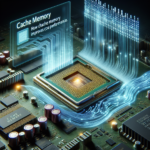How CPUs Optimize Memory Access and Bandwidth

Introduction
Central Processing Units (CPUs) are the heart of modern computing systems, responsible for executing instructions and processing data. One of the critical aspects of CPU performance is how efficiently it can access and utilize memory. Memory access and bandwidth optimization are crucial for ensuring that the CPU can perform tasks quickly and efficiently. This article delves into the various techniques and technologies that CPUs use to optimize memory access and bandwidth, providing a comprehensive understanding of this essential aspect of computer architecture.
Understanding Memory Hierarchy
Levels of Memory
Memory in a computer system is organized in a hierarchy, with each level offering different trade-offs between speed, size, and cost. The primary levels of memory include:
- Registers: The fastest and smallest type of memory, located within the CPU itself. Registers store the most frequently used data and instructions.
- Cache: A small, fast memory located close to the CPU. It is divided into multiple levels (L1, L2, L3) with L1 being the fastest and smallest, and L3 being the largest and slowest.
- Main Memory (RAM): Larger and slower than cache, RAM stores data and instructions that are actively being used by the CPU.
- Secondary Storage: Includes hard drives and solid-state drives (SSDs), which are much slower than RAM but offer significantly larger storage capacity.
Memory Access Patterns
CPUs access memory in specific patterns, which can significantly impact performance. Common access patterns include:
- Sequential Access: Accessing memory locations in a linear sequence, which is efficient for prefetching and caching.
- Random Access: Accessing memory locations in a non-linear fashion, which can lead to cache misses and increased latency.
- Strided Access: Accessing memory locations at regular intervals, which can be optimized by prefetching algorithms.
Cache Optimization Techniques
Cache Hierarchy
Modern CPUs use a multi-level cache hierarchy to optimize memory access. The hierarchy typically includes:
- L1 Cache: The smallest and fastest cache, located closest to the CPU cores. It is divided into separate instruction and data caches (L1i and L1d).
- L2 Cache: Larger and slower than L1, but still faster than main memory. It serves as a secondary cache for both instructions and data.
- L3 Cache: The largest and slowest cache, shared among multiple CPU cores. It acts as a last-level cache before accessing main memory.
Cache Coherency
In multi-core systems, maintaining cache coherency is crucial to ensure that all CPU cores have a consistent view of memory. Common cache coherency protocols include:
- MESI Protocol: Ensures that each cache line is in one of four states: Modified, Exclusive, Shared, or Invalid.
- MOESI Protocol: An extension of MESI, adding an Owned state to improve performance in certain scenarios.
- Directory-Based Protocols: Use a directory to keep track of the state of each cache line, reducing the need for broadcast messages.
Cache Replacement Policies
When a cache is full, the CPU must decide which cache line to evict to make room for new data. Common cache replacement policies include:
- Least Recently Used (LRU): Evicts the cache line that has not been accessed for the longest time.
- First-In, First-Out (FIFO): Evicts the oldest cache line, regardless of how frequently it has been accessed.
- Random Replacement: Evicts a randomly selected cache line, which can be simpler to implement but less efficient.
Memory Bandwidth Optimization
Memory Interleaving
Memory interleaving is a technique used to increase memory bandwidth by distributing memory addresses across multiple memory modules. This allows the CPU to access multiple memory locations simultaneously, improving overall performance. Common interleaving methods include:
- Bank Interleaving: Distributes memory addresses across different memory banks within a single module.
- Channel Interleaving: Distributes memory addresses across multiple memory channels, each with its own set of memory modules.
Prefetching
Prefetching is a technique where the CPU anticipates future memory accesses and loads data into the cache before it is needed. This can significantly reduce memory latency and improve performance. Types of prefetching include:
- Hardware Prefetching: Implemented within the CPU, it uses algorithms to predict future memory accesses based on past patterns.
- Software Prefetching: Implemented by the compiler or programmer, it involves inserting prefetch instructions into the code.
Memory Access Scheduling
Memory access scheduling involves reordering memory requests to optimize bandwidth and reduce latency. Techniques include:
- Out-of-Order Execution: Allows the CPU to execute instructions out of order, as long as data dependencies are respected.
- Memory-Level Parallelism (MLP): Increases the number of memory requests that can be processed simultaneously.
Advanced Memory Technologies
High-Bandwidth Memory (HBM)
High-Bandwidth Memory (HBM) is a type of memory designed to provide higher bandwidth and lower power consumption compared to traditional DDR memory. HBM achieves this by stacking multiple memory dies vertically and connecting them with through-silicon vias (TSVs). This allows for a wider memory bus and higher data transfer rates.
DDR5 and Beyond
DDR5 is the latest generation of Double Data Rate (DDR) memory, offering higher bandwidth and improved power efficiency compared to its predecessors. Key features of DDR5 include:
- Higher Data Rates: DDR5 can achieve data rates of up to 6.4 Gbps, significantly higher than DDR4.
- Improved Power Efficiency: DDR5 operates at lower voltages, reducing power consumption.
- Increased Capacity: DDR5 supports higher memory densities, allowing for larger memory modules.
Non-Volatile Memory (NVM)
Non-Volatile Memory (NVM) technologies, such as Intel’s Optane and 3D XPoint, offer the potential for higher performance and persistence compared to traditional DRAM. NVM can retain data even when power is lost, making it suitable for applications that require fast, persistent storage.
FAQ
What is the role of cache memory in a CPU?
Cache memory acts as a high-speed intermediary between the CPU and main memory (RAM). It stores frequently accessed data and instructions, reducing the time it takes for the CPU to retrieve this information. This helps improve overall system performance by minimizing memory latency.
How does memory interleaving improve performance?
Memory interleaving improves performance by distributing memory addresses across multiple memory modules or channels. This allows the CPU to access multiple memory locations simultaneously, increasing memory bandwidth and reducing latency.
What is the difference between hardware and software prefetching?
Hardware prefetching is implemented within the CPU and uses algorithms to predict future memory accesses based on past patterns. Software prefetching, on the other hand, is implemented by the compiler or programmer and involves inserting prefetch instructions into the code. Both techniques aim to reduce memory latency by loading data into the cache before it is needed.
What are the benefits of DDR5 memory?
DDR5 memory offers several benefits over its predecessors, including higher data rates, improved power efficiency, and increased capacity. These improvements result in higher memory bandwidth, lower power consumption, and the ability to support larger memory modules, making DDR5 suitable for high-performance computing applications.
How does non-volatile memory (NVM) differ from traditional DRAM?
Non-volatile memory (NVM) differs from traditional DRAM in that it can retain data even when power is lost. This makes NVM suitable for applications that require fast, persistent storage. Additionally, NVM technologies, such as Intel’s Optane and 3D XPoint, offer higher performance compared to traditional DRAM.
Conclusion
Optimizing memory access and bandwidth is crucial for maximizing CPU performance. Through a combination of cache optimization techniques, memory interleaving, prefetching, and advanced memory technologies, modern CPUs can efficiently manage memory access and bandwidth. Understanding these techniques and technologies is essential for anyone looking to gain a deeper insight into computer architecture and improve system performance.




